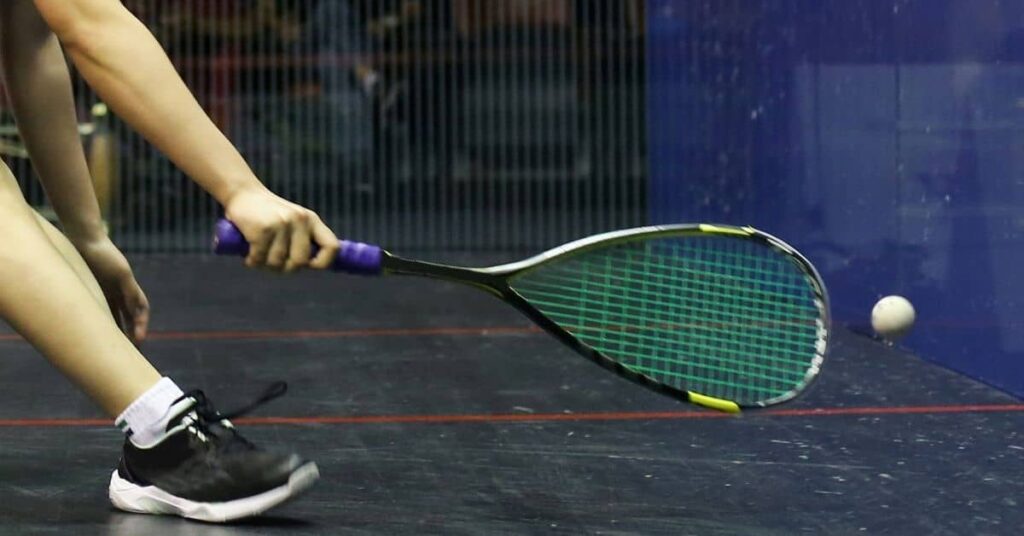I. Introduction
Squash has surged in popularity worldwide, attracting fitness enthusiasts and competitive players alike. Among the many benefits of playing squash are its ability to challenge your agility, reflexes, and strategic thinking. As one of the fastest racquet sports, it also delivers a powerful full-body workout that keeps you coming back for more.
In this article, you’ll explore the origins of squash, step onto the court with confidence, select the right gear, and master fundamental techniques. Ultimately, you’ll discover how squash transforms your physical health, mental acuity, and social life.
II. History of Squash
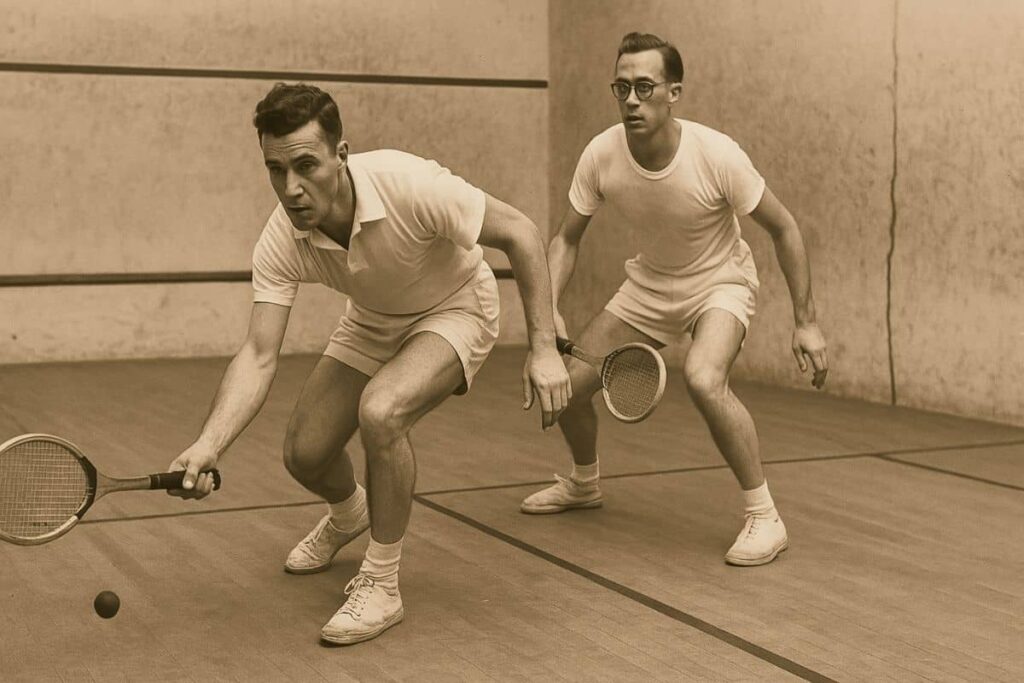
A. Origins in 19th-Century England
Squash sprouted at Harrow School around the 1830s, when students bored of playing racket ball (a predecessor to tennis) discovered that a punctured rubber ball “squashed” spectacularly on impact. Intrigued by its unpredictable rebound, they carved out a section of an old racquets court, removed one wall’s lower ledge, and began hurling the ball against smooth brick. Before long, that soft-rubber sphere defined a brand-new game—one demanding split-second reflexes and razor-sharp movement.
Within a few years, headmasters officially recognized this offshoot as “squash racquets.” Because the ball’s deformation created endless angles and constant lunges, it felt like a high-intensity workout wrapped in pure fun. Consequently, Harrow’s version of the sport quickly became the blueprint for every future court built outside those school grounds.
B. Early Rules and Key Innovations
Initially, there was no rulebook—just enthusiastic boys chasing an erratic ball. But by the 1860s, brick-by-brick courts began appearing in London’s social clubs, and club marshals drafted the first rule sets: define court dimensions, establish service boxes, and introduce a basic scoring system.
Key innovations followed. The metal-eyed racket replaced the heavy wooden bats of old, offering slimmer beams and bigger sweet spots. Club players also added the “tin”—a metal strip at the front-wall base that penalized shots struck too low. This simple addition not only standardized play but injected an extra layer of precision into every rally.
C. Global Expansion and Major Milestones
As the British Empire stretched across continents, so did squash. In the late 19th century, expatriates laid courts in India and Egypt; by World War I, Asia and North America boasted thriving membership. In 1923, England founded the Squash Rackets Association, and soon national bodies from Australia, South Africa, Canada, and the United States followed suit.
The mid-20th century marked another leap: in 1930, the first British Open—often dubbed the “Wimbledon of Squash”—crowned champions and set the stage for international rivalry. Then in 1976, the inaugural Men’s World Open celebrated Pakistan’s Imran Khan as the first world champion, igniting a golden era of Jansher and Jahangir Khan domination. Parallel to the men’s scene, the Women’s World Open debuted in 1979, spotlighting pioneers like Heather McKay and later global stars such as Nicol David.
D. Squash Today: Professional Tours & Olympic Aspirations
Fast-forward to now, and squash thrives under the Professional Squash Association (PSA) banner, with world tours spanning six continents and prize pools rivalling other major racquet sports. Iconic venues—London’s Alexandra Palace, Hong Kong’s Stanley Ho—host sold-out arenas where lightning-fast rallies and trickle shots dazzle crowds.
Despite repeated bids (notably for Tokyo 2020 and Paris 2024), squash remains outside the Olympic program. Yet, each grassroots tournament, youth-development initiative, and nationwide boom strengthens its case. As federations unite behind a modern, glass-court spectacle—and as technology captures the sport’s athletic theatre in breathtaking 360°—squash stands poised to finally make its Olympic debut, reaffirming a legacy that began with a simple “squash” echoing off a brick wall.
III. The Squash Court
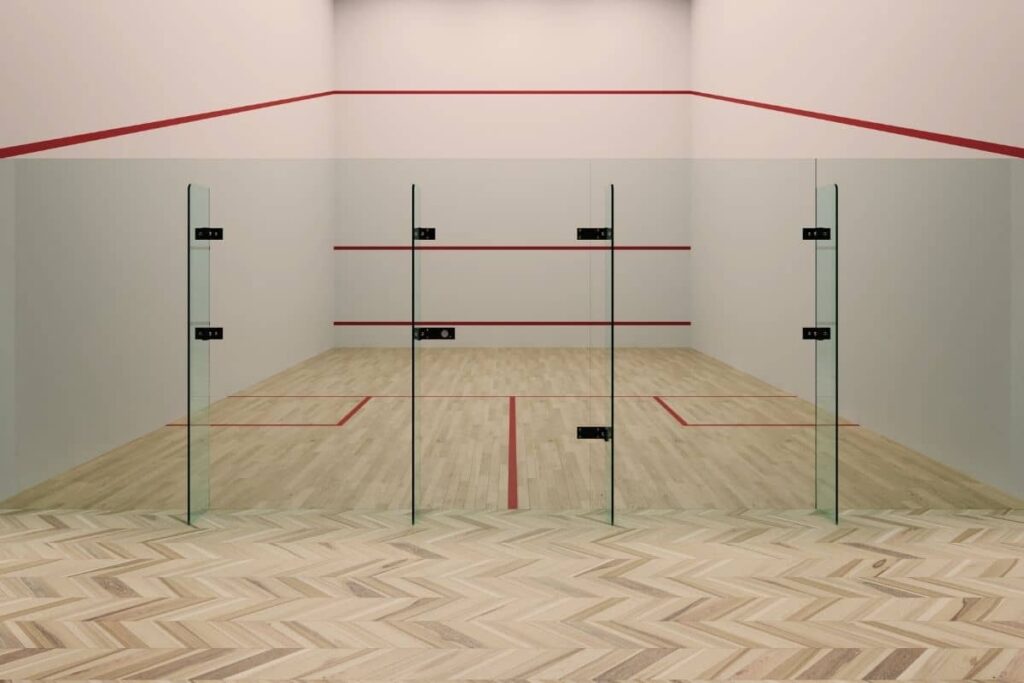
A. Standard Dimensions & Layout
First and foremost, a regulation squash court measures 9.75 m in length and 6.4 m in width. On the front wall, the tin sits 0.48 m above the floor, and it spans the entire width: any ball striking below this line is “out.” Directly above the tin, the front-wall outline perches at 4.57 m, preventing overly high shots. Meanwhile, the back wall’s outline rests at 2.13 m, ensuring the ball stays in play.
In addition to wall markings, the service boxes shape how players begin each rally. These two 1.6 m × 1.6 m squares flank the central half-court line. To serve, you must stand with at least one foot in a box and hit the ball above the front-wall service line, which is 1.78 m above the floor. Furthermore, the “T” at the junction of the service line and the half-court line serves as the strategic heart of the court: by occupying this area, you maximize reach to all corners.
B. Types of Court Surfaces
Squash courts typically feature one of three surfaces, each affecting speed, bounce, and player comfort:
- Hardwood (Maple or Oak): This classic floor delivers a crisp, predictable bounce and slightly faster rallies. Moreover, its natural grain offers reliable traction for sharp lunges.
- Glass: Often used for show courts, tempered glass walls combine spectator visibility with moderate ball speed. Although glass courts produce a slightly slower rebound than hardwood, they highlight every rally — perfect for tournaments and broadcast events.
- Synthetic (Polymer or Vinyl): Engineered for shock absorption, synthetic floors reduce joint strain and lower ball speed for beginners. Additionally, their uniform surface minimizes maintenance and resists warping in fluctuating climates.
C. Court Maintenance & Etiquette
Maintaining a squash court secures safety and enhances play. Before each match, players should sweep or dust mop the floor to remove grit, which can cause slips. Equally important, use a dry cloth to wipe sweat from walls and glass, preserving clear sightlines. Many clubs also schedule professional deep cleaning monthly to strip built-up grime and reapply appropriate floor finishes.
Etiquette goes hand in hand with upkeep. Always wear non-marking shoes to protect the court surface and replace worn soles before they harden. During rallies, call a “Let” if you accidentally block your opponent’s swing or risk collision. Likewise, acknowledge good play with a nod or brief “good shot,” fostering respect and sportsmanship. Finally, finish by re-racking balls in the cupboard or service area—this small gesture ensures the court is ready for the next players.
IV. Essential Equipment
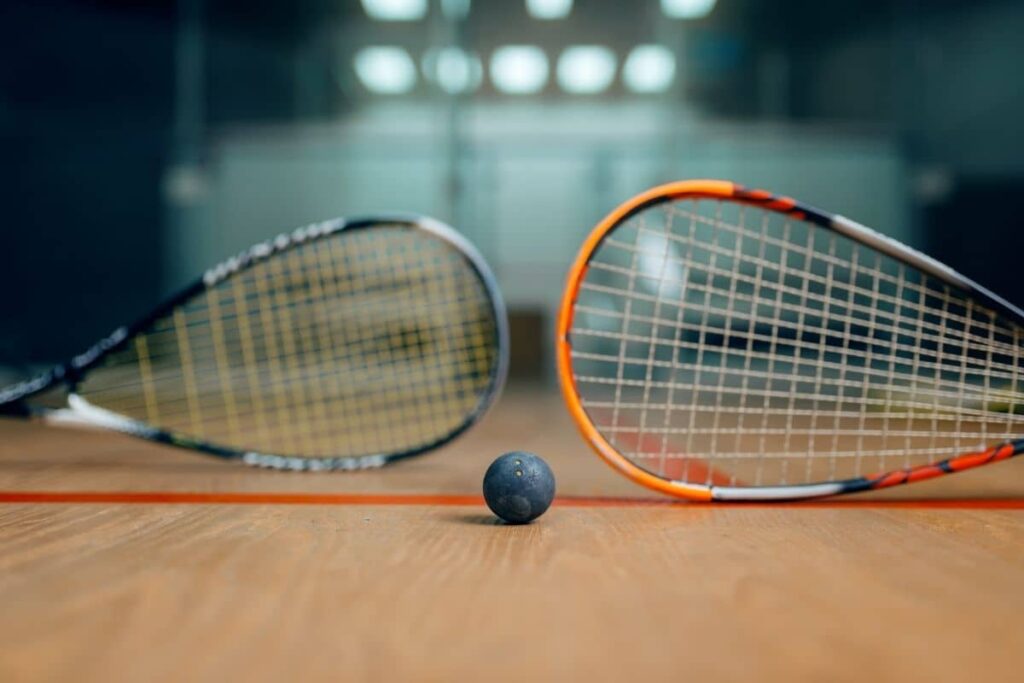
A. Choosing Your Racket
- Head Size: Larger sweet spot aids beginners; pro rackets trend smaller.
- Weight & Balance: Lighter rackets (110–130 g) boost manoeuvrability; head-light balance improves control.
- Grip & String Tension: Opt for a tacky grip and mid-tension (24–26 lbs) strings for a blend of power and feel.
B. Squash Balls Explained
- Dot System: Double yellow (slowest) for advanced players; blue or red dot for beginners.
- Temperature & Bounce: Warm the ball before play to maximize rebound and consistency.
C. Footwear & Apparel
- Court Shoes: Non-marking sole and lateral support protect ankles.
- Breathable Clothing & Eye Protection: Moisture-wicking fabric and protective goggles reduce injury risk.
V. How to Play Squash

A. Basic Rules & Scoring
First, every rally begins with one player serving and ends when the ball either:
- Bounces twice before being returned,
- Strikes tin or out-of-bounds lines,
- Leaves the court without hitting the front wall first, or
- Results in an unplayable interference.
Scoring in modern squash uses Point-a-Rally (PAR11). Consequently, each rally awards one point—regardless of who served—and matches are typically best of five games to 11 points (win by two). Alternatively, some clubs still employ PAR15 or the older Hand-In-Hand-Out system, where only the server can score.
Moreover, two interference calls shape fair play:
- Let: You replay the point if safety or a clear swing is impeded.
- Stroke: You lose the point (or award your opponent the point) if you block a winning shot or hit them with the ball.
B. The Serve & Return
To kick off a rally:
- Choose Service Box: Stand with at least one foot in either the left or right service box.
- Serve Execution: Drop or bounce the ball once on the floor, then strike it so it hits the front wall above the service line (1.78 m high) and lands in the back quarter opposite you.
- Foot-Faults: Avoid stepping on or outside the service box lines before hitting the ball; otherwise, you forfeit the serve.
After a legal serve, the receiver must return the ball before its second bounce, hitting the front wall (directly or via side/back walls) and keeping within the court boundaries. From that point on, both players alternate turns, striving to maintain one-hit rallies and exploit openings.
C. Core Shots & Techniques
Mastering shot variety keeps your opponent guessing and dictates court control. Key shots include:
- Drive (Straight & Cross-Court):
- Objective: Push your opponent to the back corners.
- Technique: Swing through low and level, brushing along the wall to maintain pace.
- Use: Early in rallies to force depth and open up space.
- Drop Shot:
- Objective: Land the ball softly just above the tin, forcing your opponent forward.
- Technique: Decelerate at contact, use a short backswing, and open the racket face.
- Use: When your opponent is pinned deep or over-committing on a drive.
- Boast (Sidewall & Three-Wall):
- Objective: Redirect the ball via one or two side walls into the front court.
- Technique: Aim the centre of the racket at the intended side-wall target, then follow through toward the front.
- Use: When your opponent holds “T” control or to surprise them with an acute angle.
- Lob:
- Objective: Reset the rally by lofting the ball high to the back wall.
- Technique: Swing upward with a longer backswing, using wrist lift to generate height.
- Use: When you need extra time to recover to the T or neutralize your opponent’s attack.
- Volley & Kill Shots:
- Volley: Intercept the ball before it bounces. It demands tight footwork and anticipation.
- Volley Kill: A volley aimed at the nick (intersection of wall and floor) or the front corners to end the rally immediately.
Watch these must-know shots in action:
► Must-Know Squash Shots Demo:
https://www.youtube.com/watch?v=EXAMPLE1
D. Positioning & “The T” Handicap
Positioning supersedes power. The central “T” (where the short-line and half-court line cross) serves as your home base:
- Recover Quickly: After each shot, move back to the T on a diagonal path to maximize reach.
- Control Angles: From the T, you can sprint to any corner with minimal movement.
- Defensive vs. Offensive Posture:
- Defensive: If you’re stretched wide or behind, drop your racket head and prepare for the next deep shot.
- Offensive: When you’ve hit a winning shot or a tight boast, step in slightly ahead of the T to seal the point.
Drills such as ghosting—mimicking court patterns without a ball—sharpen your muscle memory for efficient T recovery and prevent wasted steps.
E. Match Formats & Strategies
Squash offers both singles (1 vs. 1) and doubles (2 vs. 2), each with unique tactics:
- Singles Strategy:
- Focus on length (deep drives) to push your opponent back.
- Intermix soft front-court shots to bring them in and disrupt rhythm.
- Maintain high-tempo rallies to capitalize on your fitness advantage.
- Doubles Strategy:
- Communicate constantly to cover lobs and boasts.
- Use lateral drives to exploit open spaces created by your partner’s positioning.
- Prioritize safety passes—straight, tight shots that travel down either side wall.
In both formats, cultivate a pre-match routine: warm up with dynamic stretches, practice a few drives and boasts, then settle on a short-term goal (e.g., winning 60% of cross-court rallies) to focus your mind and chart in-match adjustments.
VI. The Benefits of Playing Squash
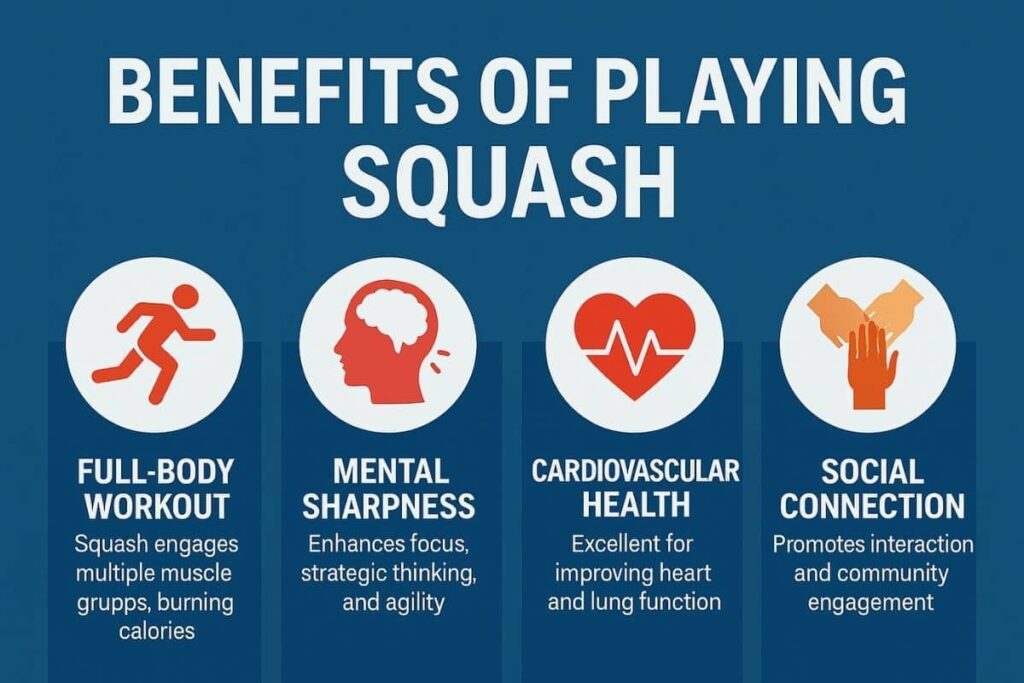
Squash delivers a multidimensional workout that pays dividends far beyond the court. In what follows, we’ll unpack each major benefit—physical, mental, social, metabolic, and neuromuscular—so you see exactly why squash stands out among sports.
A. Physical Health Benefits
First, squash functions as a natural high-intensity interval training (HIIT) session. Because rallies last 30–60 seconds, you spike your heart rate repeatedly, pushing both aerobic and anaerobic systems.
- Cardiovascular Endurance
- You train VO₂ max: lung capacity increases as you sustain fast-paced sprints and recoveries.
- Heart health improves: regular play lowers resting heart rate and blood pressure over time.
- Muscular Strength & Power
- Leg muscles (quadriceps, hamstrings, calves) develop through repeated lunges and explosive bursts.
- Core engagement surges: every twist, reach, and recovery lunge engages your abs, obliques, and lower back.
- Upper-body tone: drives, volleys, and slams heighten shoulder and forearm strength.
- Flexibility & Joint Health
- Dynamic stretches: lunging to low drops and boasts lengthens hip flexors, hamstrings, and groin muscles.
- Joint lubrication: varied movement patterns promote synovial fluid circulation, maintaining healthy knees and ankles.
By integrating squash twice weekly, you build a balanced, athletic physique—no gym membership required.
“Squash offers a full-body workout that boosts cardiovascular health, builds muscular strength, and enhances flexibility—making it one of the most effective sports for overall fitness.”
→ Discover the top health benefits of playing squash.
B. Mental & Cognitive Perks
Squash isn’t just physical—it’s a mental chess match played at lightning speed.
- Enhanced Focus & Decision-Making
- You read your opponent’s body language and ball trajectory in milliseconds, sharpening situational awareness.
- Strategic shot-selection (drive vs. drop vs. boast) trains executive function and rapid problem-solving.
- Stress Relief & Mood Boost
- High-intensity effort triggers endorphin release, reducing cortisol and lifting your mood.
- The “flow state” of long rallies distracts from daily worries, offering a form of active meditation.
- Memory & Pattern Recognition
- Recalling opponents’ tendencies (e.g., favourite backhand boast) strengthens working memory.
- You learn to anticipate shot patterns, reinforcing neural networks for faster reflexes.
C. Social & Lifestyle Advantages
Beyond the sweat and strategy, squash fosters community and personal growth.
- Club Culture & Networking
- Squash clubs bring together students, executives, and retirees—creating cross-generational bonds.
- Ladder leagues and social mixers expand your professional network in a relaxed setting.
- Friendly Competition & Accountability
- Regular matches build camaraderie: you strive to improve together and hold each other to higher standards.
- Group clinics and team events instil discipline, making fitness a shared commitment.
- Travel & Cultural Exchange
- Tournaments in cities worldwide introduce you to new cultures—and new playing styles.
- Exchanges and squash festivals broaden your horizons, both on and off the court.
D. Weight Management & Metabolic Boost
If weight control tops your goals, squash proves one of the most efficient calorie-torchers.
Infographic: Calorie Burn Comparison (per hour)
| Sport | Calories Burned | |
| Squash | 800 kcal | ████████████ |
| Running | 700 kcal | ██████████ |
| Cycling | 600 kcal | ████████ |
| Swimming | 500 kcal | ██████ |
| Tennis | 600 kcal | ████████ |
Estimates for a 70 kg adult engaging in moderate-to-vigorous play.
- Peak Calorie Burn
- Short, explosive rallies spike energy expenditure—often higher than steady-state cardio.
- Excess Post-Exercise Oxygen Consumption (EPOC)
- After matches, your body continues to burn calories as it restores oxygen levels, clears lactic acid, and repairs muscle fibres.
- Metabolic Flexibility
- Regular squash trains your muscles to switch between fat and carbohydrate fuels efficiently, aiding long-term weight stability.
E. Enhanced Agility, Coordination & Reflexes
Finally, squash fine-tunes your neuromuscular system:
- Footwork & Balance
- Lunges in every direction sharpen single-leg stability and proprioception.
- “Ghosting” drills engrain efficient movement patterns, reducing wasted steps.
- Hand-Eye Coordination
- Tracking a small, fast ball against varied backgrounds accelerates visual processing and reaction time.
- Reflexive Responses
- Instant adaptations to unpredictable ricochets improve overall athleticism and may translate to better performance in other sports—tennis, basketball, even martial arts.
By weaving together these benefits, squash becomes not simply a game but a holistic catalyst for physical vitality, mental clarity, and social connection. So, step onto the court, rally hard, and let squash reshape your life—one serve at a time.
VII. Getting Started & Next Steps
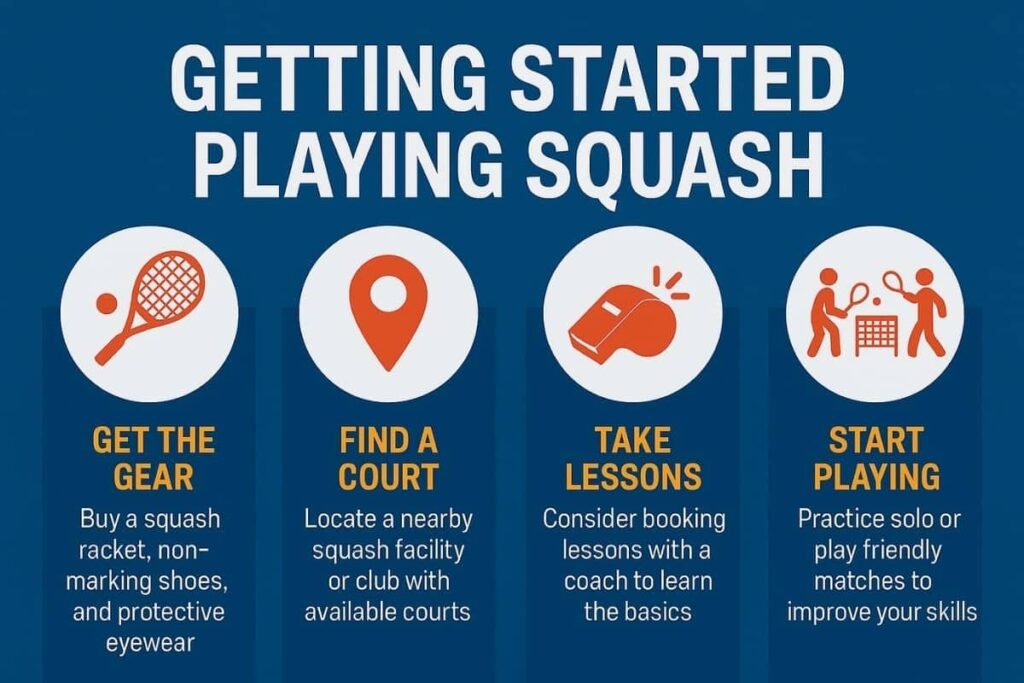
A. Finding Local Clubs & Courts
First, cast a wide net when searching for courts near you. Start by checking community centres, universities, and private sports clubs online—many list squash facilities, membership fees, and drop-in schedules on their websites. Next, explore dedicated apps like CourtReserve or PlaySquash, which let you filter by location, court type (hardwood, glass, synthetic), and availability. Moreover, don’t overlook corporate gyms and YMCAs; they often offer squash “guest passes” for a nominal fee. Finally, swing by prospective venues in person: a quick tour can reveal court conditions, lighting quality, and the general club atmosphere, helping you decide where you’d feel most motivated.
B. Beginner Programs & Clinics
Once you’ve shortlisted a club, look into beginner-specific offerings. Many clubs roll out “squad” programs—small, coach-led groups capped at four to six players—for four to six weeks. These clinics typically cover basic rules, warm-up routines, stroke mechanics, and simple match play. Tuition ranges from $50–$150 depending on facility prestige and coach credentials. Alternatively, some associations partner with schools and youth centres to provide subsidized “intro to squash” days, complete with complimentary rackets and balls. Be sure to ask about equipment rental options; borrowing gear initially saves you from premature purchases until you’ve settled on your preferred racket and ball type.
C. Coaching, Drills & Practice Routines
To accelerate learning, invest in periodic one-on-one coaching sessions. A certified coach will dissect your technique, correct grip issues, and tailor drills to shore up your weaknesses—be it footwork, backhand consistency, or volley placement. Meanwhile, establish a balanced practice regimen:
• Footwork Drills: Ghosting patterns—shadowing lunges and sprints in the shape of an “X” on the court—engrains efficient movement and T-recovery.
• Shot Repetition: Multi-ball drills with a partner or ball machine help you groove drives, drops, and boasts under fatigue.
• Conditioning Circuits: Combine short sprints (20 m), side-shuffles, and body-weight exercises (lunges, planks, squats) in 4–5-round intervals to mimic match intensity.
For visual guidance, follow this structured footwork routine:
► Footwork Drills Demo:
https://www.youtube.com/watch?v=EXAMPLE2
Rotate these elements weekly—one day dedicated to technical drills, another to match-play scenarios—to keep practice engaging and comprehensive.
D. Progress Tracking & Goal setting
Finally, transform vague aspirations into clear achievements with SMART goals (Specific, Measurable, Achievable, Relevant, Time-bound). For example:
- Specific: Increase back-court drives landing within 0.5 m of the back wall.
- Measurable: Track accuracy by logging 20 drives per session and recording how many hit the target zone.
- Achievable: Aim for a 60% success rate within six weeks.
- Relevant: This shot deepens rallies and forces opponents into defensive positions.
- Time-bound: Reassess progress after 12 practice sessions.
Use a squash journal or smartphone apps like SquashScores to log match outcomes, drill performance, and fitness metrics (heart rate, sprint times). Periodically review your notes with your coach to adjust practice focus. Additionally, consider wearable tech—GPS court trackers and wrist accelerometers—that capture movement patterns and shot speeds, granting insights you wouldn’t glean by eye alone. By systematically measuring and refining each component, you’ll transform early enthusiasm into steady, quantifiable improvement—and set the stage for serious squash success.
VIII. Embrace Your Squash Journey
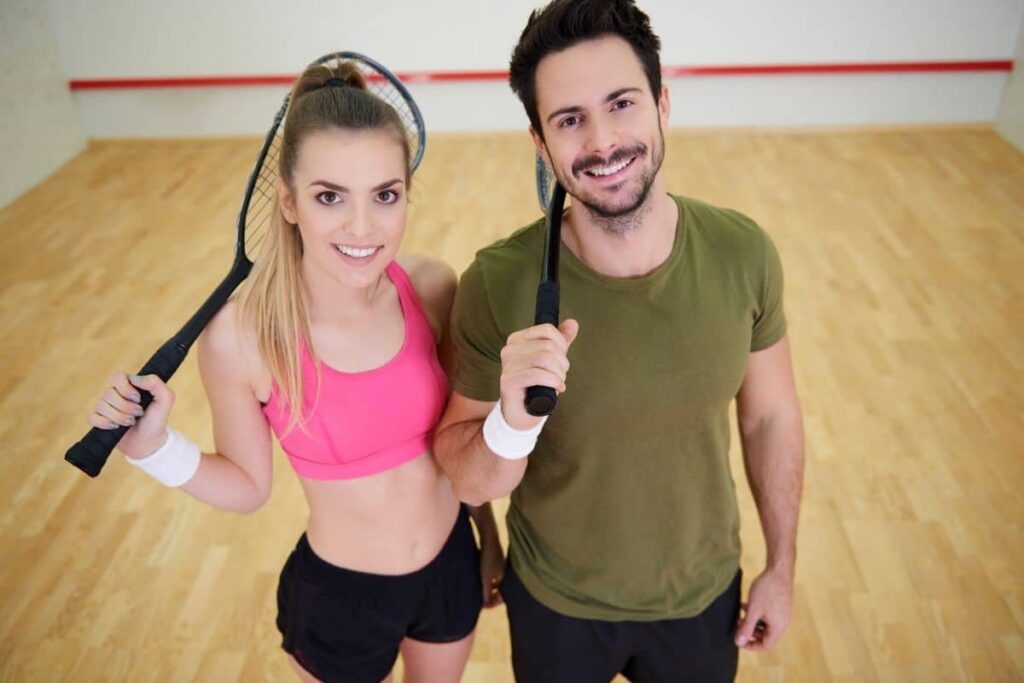
Now that you’ve absorbed squash’s rich heritage, mastered the court layout, selected the right gear, honed essential techniques, reaped powerful health and social benefits, and mapped out your first steps, it’s time to fully embrace your squash journey. This phase isn’t a finish line—it’s the launch pad for continuous growth, discovery, and enjoyment.
1. Define Your Personal Path
Begin by envisioning what “success” looks like for you. Maybe you dream of winning your first club ladder match, completing a 60-minute continuous rally, or simply feeling more confident lunging low to retrieve drop shots. By setting tiered milestones—novice (learn all basic shots), intermediate (win three out of five local matches), advanced (enter a regional tournament)—you create a vivid roadmap. Consequently, every practice session and match gains meaning, because you know exactly which skill or strategy, you’re sharpening next.
2. Cultivate the Right Mindset
Squash demands resilience as much as athleticism. Inevitably, you’ll hit plateaus where improvement feels elusive. Rather than view these stalls as failures, reframe them as essential recalibrations. For instance, if drives keep catching too high, pause to revisit your racket’s angle during shadow swings. Likewise, track small victories—your first perfectly executed boast, or beating your previous rally record—to fuel motivation. With patience and deliberate practice, those frustrating hurdles become the foundation of long-term progress.
3. Engage with the Community
Beyond one-on-one coaching, immerse yourself in your squash community. Join ladder leagues where weekly matches challenge you to adapt to varied playing styles. Volunteer at club events or junior clinics to reinforce your fundamentals by teaching others. Moreover, attend social mixers or team tournaments; sharing post-match reflections over coffee deepens camaraderie and often sparks tactical insights you wouldn’t discover solo. Remember: your fellow players won’t just be opponents—they’ll become your support network and biggest cheerleaders.
4. Diversify Your Training
As you solidify basic strokes, broaden your repertoire with advanced drills. Experiment with deceptive shots—nick targets, double-boasts, and tight volley kills—to keep opponents guessing. Supplement court work with off-court conditioning: plyometric box jumps enhance explosive lunges, while rotational medicine-ball throws boost your twist-and-reach power. Furthermore, integrate yoga or dynamic stretching into your weekly routine to preserve flexibility and ward off overuse injuries. By blending technical, tactical, and physical elements, you’ll evolve into a more complete athlete.
5. Leverage Technology & Feedback
Today’s squash players benefit from an array of digital tools. Record your matches and drills with a smartphone or action camera, then review footage to analyse footwork patterns and shot mechanics. Use wearable trackers to monitor sprint distances, court coverage, and heart-rate zones, then adjust your conditioning plan accordingly. Additionally, seek structured feedback: schedule quarterly check-ins with your coach, set new SMART goals backed by data, and celebrate each benchmark you surpass.
6. Explore Competitive & Recreational Formats
Keep the spark alive by varying how you play. Enter local tournaments for the adrenaline of knockout matches. Switch to doubles to cultivate teamwork and sharpen your reflexes in tighter spaces. Try a “fun format” like one-wall squash or even “racket-ball” variations to rediscover joy in simpler rallies. Each format highlights different skills, ensuring you never get bored and always find fresh challenges.
7. Integrate Squash into Your Lifestyle
Treat squash not as an occasional hobby but as a core pillar of your well-being. Schedule regular court sessions as you would important meetings—block off time in your calendar and honour it. Fuel your body with lean proteins, complex carbs, and hydration that sustain high-intensity bursts. Prioritize sleep and active recovery—foam rolling, massage, and light cross-training—to keep your joints and muscles primed for the next match.
8. Celebrate Every Serve and Rally
Finally, remember to enjoy the journey. Every perfect serve, every narrowly saved boast, and every post-match fist bump constitutes progress. Revel in the laughter, the camaraderie, and the occasional heartbreak—they all shape your squash story. Ultimately, squash rewards those who embrace both its rigor and its delight. So, step back onto the court tomorrow with curiosity in your heart, determination in your legs, and a smile on your face—your next great rally awaits.
IX. Frequently Asked Questions
Q1: Which squash ball should beginners use, and how do I progress?
Beginners should start with a blue-dot ball, since its higher bounce extends rallies and builds confidence. To choose:
- Warm the ball before play by bouncing it for 30–60 seconds; a cold ball can feel dead and unresponsive.
- Test rebound height: a properly warmed blue-dot should bounce to about shoulder height.
As your skill and fitness grow, transition to a red-dot (slower) and then a double-yellow-dot (slowest, hardest) ball. This progression challenges your shot precision, timing, and endurance step by step.
Q2: How often should I practice to see real improvement?
Aim for 2–4 sessions per week, blending:
- Technical Drills (1–2×/week):
– Ghosting and footwork patterns to reinforce T-recovery.
– Multi-ball or coach-fed sessions for shot repetition. - Match Play (1×/week):
– Competitive or friendly games to apply tactics under pressure. - Conditioning (1–2×/week):
– Interval circuits (sprints, lunges, agility ladders).
– Strength work (squats, deadlifts) emphasizing explosive leg power.
By alternating focus—technique, tactics, and fitness—you avoid burnout and ensure balanced development.
Q3: Can squash really help with weight loss, and how should I structure my workouts?
Absolutely. Squash’s high-intensity rallies can burn 700–800 kcal per hour, plus an EPOC (afterburn) effect that elevates calorie burn post-match. For weight management:
- Schedule three 60-minute sessions per week.
- Combine with a moderate calorie deficit diet: prioritize lean proteins, vegetables, and whole grains.
- Track progress: use a journal or app to log calories in/out, session durations, and body measurements monthly.
- Add one low-intensity day—like a brisk 30-minute walk—to boost recovery and fat metabolism without overtaxing your muscles.
Q4: Do I really need specialized squash shoes? What should I look for?
Yes—proper court shoes reduce injury risk and protect the floor. Key features:
- Non-marking, grippy sole to prevent slips during rapid direction changes.
- Lateral support (reinforced sidewalls) to stabilize your ankle in lunges.
- Cushioning that absorbs impact—look for midsole foam rated for multi-directional shock.
- Lightweight design (<350 g) so your feet feel agile.
Brands like ASICS, Salming, and Hi-Tec offer models specifically tuned for squash dynamics.
Q5: Is it safe to learn squash without a coach, and how can I minimize mistakes?
Self-teaching works for basic rallies, but without guidance you risk ingraining poor technique and developing overuse injuries. To mitigate this:
- Use Online Resources: Watch these demos to model proper form:
- Must-Know Shots: https://www.youtube.com/watch?v=EXAMPLE1
- Footwork Drills: https://www.youtube.com/watch?v=EXAMPLE2
- Record Yourself: Film serves and drives; compare to pro tutorials to self-correct posture and swing path.
- Join Casual Play: Partner with more experienced players who can offer real-time pointers and stop you making bad habits.
- Periodic Clinics: Even a quarterly 1-hour session with a certified coach can recalibrate your technique and prevent long-term errors.
Q6: What’s the best way to track my progress and set goals?
Use the SMART framework:
- Specific: “Improve my back-court drive accuracy to land within 0.5 m of the back wall.”
- Measurable: Log 20 drives per session and note how many hit your target.
- Achievable: Aim for a 60% success rate within six weeks.
- Relevant: A deep, accurate drive keeps opponents on the defensive.
- Time-bound: Reassess after 12 sessions.
Combine a squash journal or app (e.g., SquashScores) with wearable trackers that record sprint distances and heart-rate zones. Review metrics weekly with a coach or training partner.
Q7: At what age can I start squash, and is it suitable for seniors?
Squash welcomes all ages:
- Kids (8+): Many junior programs use softer, slower balls and shorter rackets to build fundamentals safely.
- Adults: Novice leagues often group players by ability, not age, so you compete with peers at the same level.
- Seniors: Modified sessions (lower-impact drills, longer rest intervals) maintain heart health, flexibility, and balance—key factors in aging gracefully. Always check with a physician before starting high-intensity sports.
Q8: How do I find and connect with squash partners?
Leverage multiple channels:
- Club Noticeboards & Apps: Post “Looking for Partner” notices or use platforms like CourtReserve.
- Social Media Groups: Search local “Squash Meetup” or “City Name Squash” on Facebook.
- Ladder Leagues & Round Robins: Many clubs host weekly ladder events where players of similar skill rotate through quick matches—perfect for meeting new partners.
- Friends & Colleagues: Invite coworkers for a free trial at your gym; casual mixed-ability games often convert newcomers into regular partners.

